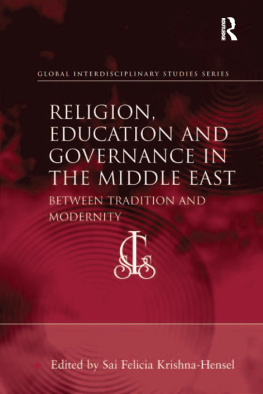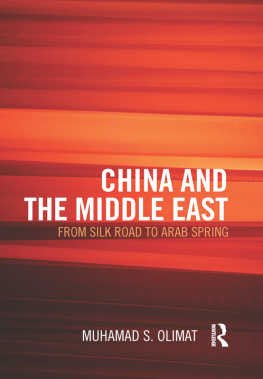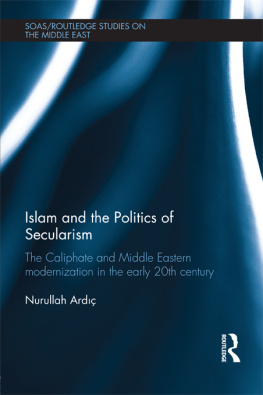INTRODUCTION: CHRONIC INSTABILITY IN THE MIDDLE EAST
MODERNISATION AS THE CAUSE OF INSTABILITY IN THE MIDDLE EAST TOO SLOW OR TOO FAST?
The academic, media and public discourse regarding the development of the post-colonial Middle East has long featured two viewpoints that, on the face of it, are diametrically opposed. The first claims the region is backward and rigid, with change taking place too slowly, if at all. The second believes that the region is transforming too quickly and that this is traumatising and destabilising local societies.
This book offers an alternative way of looking at the issue that brings together these two apparently contradictory viewpoints. It conducts a theoretically original and empirically substantiated analysis of the structural causes of Middle Eastern social and political instability, an instability manifest externally in many different forms: the protracted crisis of governing regimes and their ideologies and legitimacy; an upsurge in different ideologically driven opponents of these regimes in the form of oppositional political Islam and pro-democracy movements; a surge in political violence in the form of terrorism, civil wars or revolutions during the Arab Spring; the chronic post-revolutionary instability of the region, the collapse of many local states and the erosion of social order resulting in chaos, anarchy and interregnum.
Monitoring these external, constantly changing manifestations of pan-regional instability means understanding the Middle East as a dramatic chessboard full of constantly materialising and disappearing state and non-state actors enforcing their interests, promoting their ideologies, and competing with each other, while at the same time entering into often unexpected coalitions or, indeed, dissolving them equally unexpectedly. However, the aim of this book is to offer an explanation of the deeper causes of a chess game that is being played ever faster and during which new pieces are being added and the chessboard itself being redrawn, along with the very rules of the game. A new Middle East is emerging, one completely different to that which we have been accustomed to for decades.
How is it possible that, while over the last fifty years the Middle Eastern political chessboard was one of the most stable, predictable and boring in the world, controlled as it was by the same figures playing in accordance with the same strategies, over the last few years the pace of history has sped up beyond recognition? I will argue that this is the consequence of the impacts of long-term, subterranean social changes that have been taking place over the last fifty years but have been hitherto unobserved, since most observers have concentrated on the political game and not on the changes to its deeper demographic, social, economic and political determinants. And yet the character of these changes is strikingly reminiscent of what was a politically and socially destabilised Europe during the 19th and early 20th centuries. Reminding ourselves of recent European demographic and social history offers the possibility of better understanding the causes of the current turmoil in the Middle East.
EXCESSIVELY SLOW SOCIAL CHANGE
Those subscribing to the first viewpoint referred to above see the Middle East as an underdeveloped region, in which islands of modernity, progress, education and Western culture are surrounded by an ocean of medieval ignorance, obscurantism and Islamic-backed reactionary forces. According to this analysis, the region is experiencing a form of schizophrenia, with one leg in the camp of modernity, and the other still firmly planted in tradition (e.g. Longrigg, Jankowski 1963). More sophisticated versions of this line of argument describe the Middle East as a region inhabited by people who for the most part have not yet adapted psychologically to the modern world. Mentally they languish somewhere in the Middle Ages and its traditions. They cannot be described as modern because they are not sufficiently educated, socially mobile and informed. The boundaries of their community are the boundaries of their world. They are stuck in a time warp of tradition. They are walking backwards into the future, as it were, so as to replicate as faithfully as possible the patterns of behaviour, identities and aspirations of previous generations, which represent their role model and authority. They do not possess new, expanding consumer and career aspirations, and as a consequence lack an advanced sense of empathy, namely the ability to imagine alternatives to their life and the organisation of their community or wider society. They do not perceive themselves to be an active subject capable of changing the course of history according to a programme conceived of in advance, but as a passive object simply being dragged along by history and destiny (e.g. Lerner 1964, cf. Bah 2008). The more vulgar, borderline racist interpretation of the immutability of the region speaks of what it calls the Arab mind, a specific, unchanging personality archetype common to all Arabs characterised by an aversion to manual work, an obsession with sexuality, an overabundance of pride, a partiality for conspiracy theories, a reluctance to accept reality, an unwillingness to submit to anything other than power, and a comprehensive backwardness (e.g. Patai 1973, Friedman 2006).
The latest perspective on the region is the influential series of studies entitled the Arab Human Development Report (2002, 2003, 2005, 2009), compiled under the auspices of the UN by Arab scholars and intellectuals. These reports traced the deeper cause of the backwardness of the Arab world back to a combination of three deficits: the freedom deficit, womens empowerment, and the knowledge deficit. Democratisation and the promotion of constitutional liberalism are not taking place, while, on the contrary, authoritarian and oppressive regimes persist. The status of women is not improving fast enough. The participation of women in different social spheres remains low, while oppression and discrimination remains high. As a consequence the human potential of an entire half of the population lies idle. Finally, the reports authors say, the region is unable to mount an effective fight against illiteracy and to produce a sufficiently well educated population. It is unable to generate innovation and new knowledge. On top of this it is unable to avail itself of the innovations and knowledge generated elsewhere in the world. The Arab world lags behind other global regions in all respects.
One of the consequences is a lack of economic growth. In addition, what economic growth there is fragile, since it is wholly dependent on the export of raw materials, a burgeoning, ineffective state sector, and on family businesses from the informal sector on the boundary of the grey economy that are incapable of generating stable jobs or expanding because they cannot apply for bank loans. By contrast, the sophisticated output of stable firms with high value added plays a minimal role. Job creation is sluggish and the region is unable to compete within the global economy. Another consequence of the three deficits is the lack of functioning state institutions that would ensure effective, transparent and high quality governance and thus a reliable framework for economic development and a tranquil, safe life for the population. Quality of life lags behind other regions of the world because of the ongoing risk of poverty, poor health and deteriorating nutritional and ecological standards (AHDR 2002, 2003, 2005, 2009).








